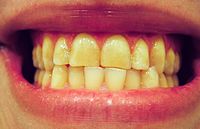
Photo from wikipedia
Purpose Fractures of the lateral condyle are the second most frequent elbow fractures in children. Although the pathobiomechanism is well known and different fracture classifications exist, there are still adverse… Click to show full abstract
Purpose Fractures of the lateral condyle are the second most frequent elbow fractures in children. Although the pathobiomechanism is well known and different fracture classifications exist, there are still adverse clinical results. This raises the questions how precise classifications predict fracture stability, especially in the context of choosing the best therapy. It also remains unclear how these classifications can be applied in practice. Methods Seventy-five patients with a fracture of the lateral condyle were analyzed in this retrospective study. We included all patients with an age ≤ 14 years admitted at a German Level I Trauma Center between 2005 and 2017. Different classifications according to Jakob, Finnbogason, Song and Hasler/v. Laer have been applied. Results Seventy-five patients with fractures of the lateral condyle were analyzed thereof 53 treated operatively and 22 conservatively. In sum, 6 out of 75 fractures showed no lateralization (Jakob: stable) in the first X-ray, but the same wide of the fracture gap medial as lateral (Finnbogason and Song: unstable). In 2 out of 75 patients, fracture instability occurred although it was not detected by the classification of Jakob, Finnbogason, Song and Hasler/v. Laer. Conclusion Classifying fractures according to the Jakob-Classification has limitations if notable rotation without lateral displacement occurs. Hasler/v. Laer’s classification appears most adequate but can sometimes not be applied due to missing X-ray 4 days after trauma. The Finnbogason- and Song-Classification performs best in prediction of instability based on the X-ray at the time of accident because of considering the fracture pathobiomechanism. All in all, we recommend the classification of Hasler and v. Laer, because it is the best predictive classification.
Journal Title: European Journal of Trauma and Emergency Surgery
Year Published: 2020
Link to full text (if available)
Share on Social Media: Sign Up to like & get
recommendations!